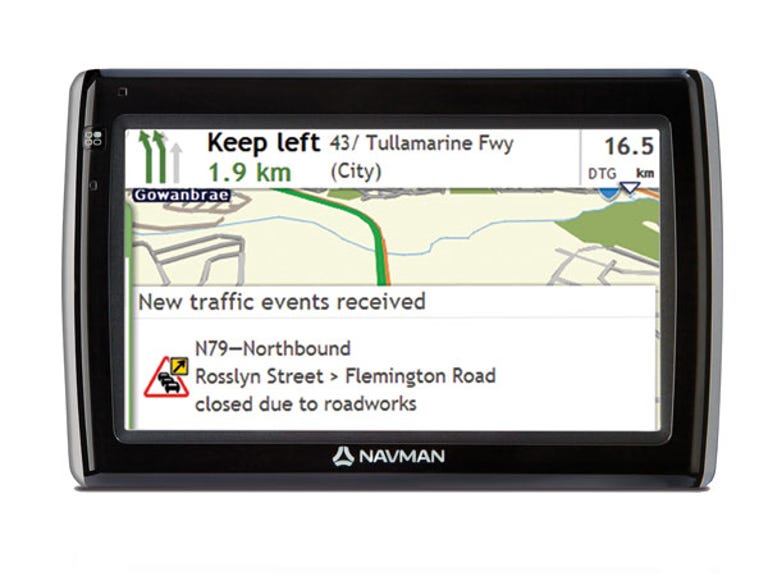 Why You Can Trust CNET
Why You Can Trust CNET Navman MY50T review: Navman MY50T
Step up to the MY50T and you'll get a larger than normal 4.7-inch touchscreen, traffic messaging with a lifetime Suna subscription, and Google or TrueLocal searches via a Bluetooth internet connection.
Design
With its piano black front and faux-metal plastic back, the MY50T isn't quite as spiffy as the preceding line of S-Series Platinum models. What it gives up on the runway, though, it more than makes up for in terms of usability.
The Good
The Bad
The Bottom Line
Thanks to its stark minimalist look and big colour main menu icons the interface looks to be a straight carry over from last year's much derided Glide Touch system. Improvements have been made and the system can now more accurately determine the difference between a button press and an attempt at scrolling. As the MY50T is only fitted with a pressure sensitive screen, it's laggier and more error prone than the darling of the touchscreen crowd, Apple's iPhone. Possibly chastened by scathing user feedback, Glide Touch is disabled by default in favour of the button scrolling system found in all other portable GPS devices.
In general, it works well, although some screens, such as the route overview, are clearly designed with swipe to scroll in mind. We're big fans of the keyword destination search, but some features, like volume control, require way too many button presses. The MY50T's processor seems to lack the requisite grunt to pull off many animations, which crawl on and off screen with efficacy of a drunk caterpillar, although route calculation is prompt enough.
At 4.7 inches diagonally, the screen is larger than the 4.3-inch norm, although resolution remains at the class standard 480x272. We didn't notice the extra screen space until we placed it side by side with another GPS, though. While the screen is no longer flush, it's now matte, so driving during the daytime is much more pleasant. Physical controls are limited to a touch-sensitive Home button in the top left corner and an on/off/reset slide switch along the top. The windscreen mount is quite compact for easy storage and — hooray — comes pre-assembled.
Features
As its name suggests, the MY50T includes traffic messaging as standard — indeed, it's currently the cheapest available GPS with traffic — with the traffic antenna hidden in the recharging cable. A lifetime subscription to the Suna traffic messaging service is included with the device; at the time of writing the service is available in Sydney, Melbourne, Brisbane, Gold Coast, Adelaide and Perth. Traffic performance is passable; on several occasions we ran into delays on roads we can only assume were too minor for Suna to monitor, while in other instances we ran into reported incidents that had already cleared.
Bluetooth is included, but it's only to enable Google and TrueLocal point of interest searches, not hands-free. Despite our best efforts we were unable to establish a data connection on either an Apple iPhone or a Palm Centro. 3D landmarks become semi-transparent as you approach them, but even then it's distracting, especially in the CBD.
Speed and red light camera alerts work well with large visual warnings and an audio ping, but, as with other brands, the warnings only occur when you're driving in certain directions. As school zone warnings pop up within a half kilometre radius of a learning institution, regardless of the time of the day or whether the road actually has a 40km/h conditional speed limit, we began to tune out all camera alerts.
As a tease Navman has included guide book point-of-interest information only for the ACT; Australia-wide data is only included on the top-of-the-range MY500XT.
Performance
An annoying trait we've discovered in GPS devices fitted with Navteq maps is a peculiar fondness for illegal turns and u-turns. This presumably is because many traffic restrictions, like no right turns, blocked median strips and the like, have yet to be captured by Navteq into its mapping data. As with any GPS device there's a fondness for main roads and sometimes confused positioning in the CBD, where the satellite signal is obscured or bounced off tall buildings.
Phoneme information included in Navteq's maps allows the text-to-speech engine to more accurately mimic Australian pronunciation for common or popular street names, like Parramatta or Macquarie, but some still slip through the net. Volume range for instructions is good and the voices are clear and comprehensible.
Traffic light locations are included with the package and make driving without looking at the screen a more frequent occurrance — being told to "turn left at the traffic light" is considerably easier to understand while on the move than "turn left in 300 metres". Unfortunately, this information isn't used in route calculation; often times, when we ventured off the preferred route, the Navman would guide us back on to a major road via a right turn that doesn't employ traffic lights.
Conclusion
Thanks to its larger than normal screen, good looks, keyword destination searches, banishment of swipe to scroll and the inclusion of traffic messaging at AU$400, the MY50T warrants inclusion in any GPS shortlist. If Navman had decided to use Bluetooth for hands-free communication, rather than internet searches, we'd be talking about an Editors' Choice award.


